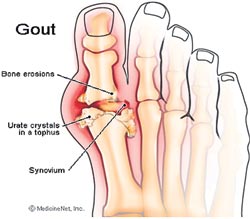
More about GoutAcute attacks of gout are usually treated by non-steroidal anti-inflammatory drugs (NSAIDs). These are tablets that relieve pain and help inflammation go down. They are so called because they do not contain steroids. Indometacin was often the first drug rheumatologists would choose, but there are now many other NSAIDs which can be used.
Used for the short periods needed to treat an acute attack, NSAIDs are unlikely to cause side-effects. But occasionally you may notice indigestion, a rash, headache, dizziness or even asthma. Anyone who has had a peptic ulcer should be especially careful and should make sure that their tablets are taken either with a meal or straight after eating. Steroids If an acute attack of gout does not respond to treatment, your doctor may have to prescribe a cortisone-type drug (a steroid). Colchicine This old-fashioned remedy is obtained from the meadow saffron - the autumn crocus. It is safe and works well. Protecting the joint A painful joint such as the big toe may be protected by placing a 'cage' over it to take the weight of your bedclothes off it. Is there preventive treatment? The drugs given to relieve an acute attack have little effect on urate levels in the blood, to prevent further attacks, or to stop urate being laid down in the joints. Should your attacks become more frequent, or if blood tests show you are accumulating too much urate, your doctor may decide to prescribe one of the drugs that reduce the quantity of urate in the blood. These have to be taken every day, whether you have an attack or not, as a preventive measure. There are now several drugs which will do this satisfactorily but you may have to persist with the daily treatment for the rest of your life. Should you stop, urate will begin to accumulate again. The most common of these tablets is allopurinol. This reduces the amount of urate made by the body. It is remarkably safe even when taken for years - the only side-effect that occurs is a rash, which disappears when the tablets are stopped. Sometimes acute attacks of gout may actually become more common when these drugs are started, so it may be necessary to take colchicine or an NSAID as well. What about diet? Weight The most effective dietary treatment for gout is losing weight if you are overweight. This can significantly reduce urate levels in your body, but it must be done gradually because extreme weight loss or starvation diets (fasting) can actually raise urate levels (because they increase cell breakdown in the body). Alcohol Excessive alcohol consumption has been associated with gout for centuries. If you have gout it is advisable to keep your alcohol intake below the safe maximum levels recommended. Currently this is 3-4 units a day for men and 2-3 units a day for women. Fluids To reduce the risk of urate crystallising in the joints (the cause of the severe pain in attacks of gout) it is important to drink plenty of water - if possible as much as 3.5 litres (6 pints) a day. You can include some other fluids in this total (not beer or other alcoholic drinks), but if you are trying to lose weight bear in mind that many soft drinks contain large amounts of sugar and should be avoided. Food Urate is produced from purines, which are chemicals that result from the breakdown of cells. Cutting down on foods which are high in purines can be helpful. These foods include: Liver, offal, anchovies, fish roes, herring, mackerel, sardines, beer and yeast extracts (e.g. Marmite). Urate levels are not affected by so-called 'acidic foods' like oranges or grapefruit, so you can eat these safely. (The writer is Consultant Rheumatologist at the Sri Jayawardenepura Hospital) |
|| Front
Page | News | Editorial | Columns | Sports | Plus | Financial
Times | International | Mirror | TV
Times | Funday
Times | Medi Scene || |
| |
Copyright
2007 Wijeya
Newspapers Ltd.Colombo. Sri Lanka. |
